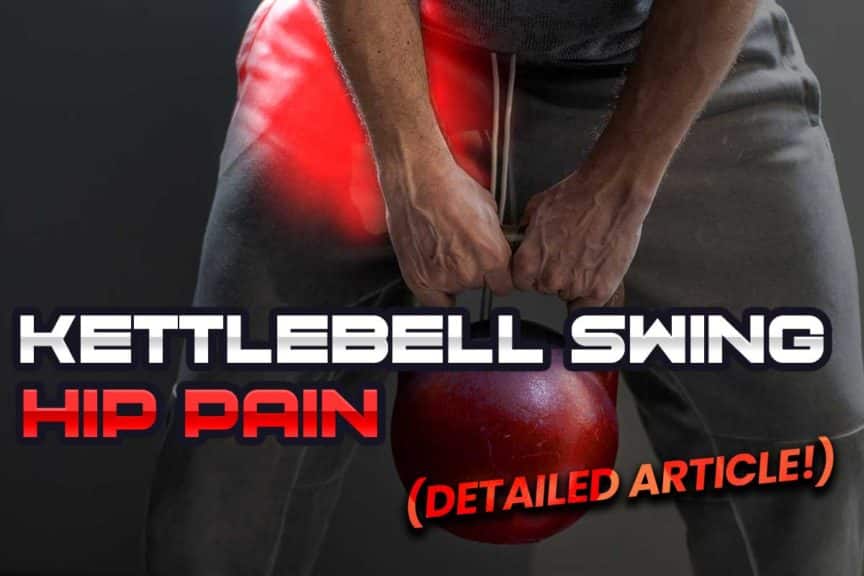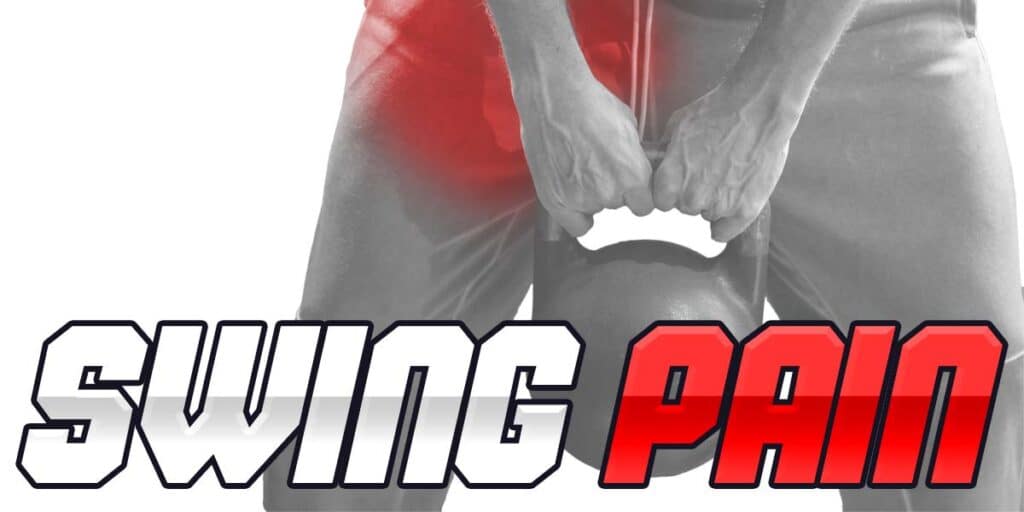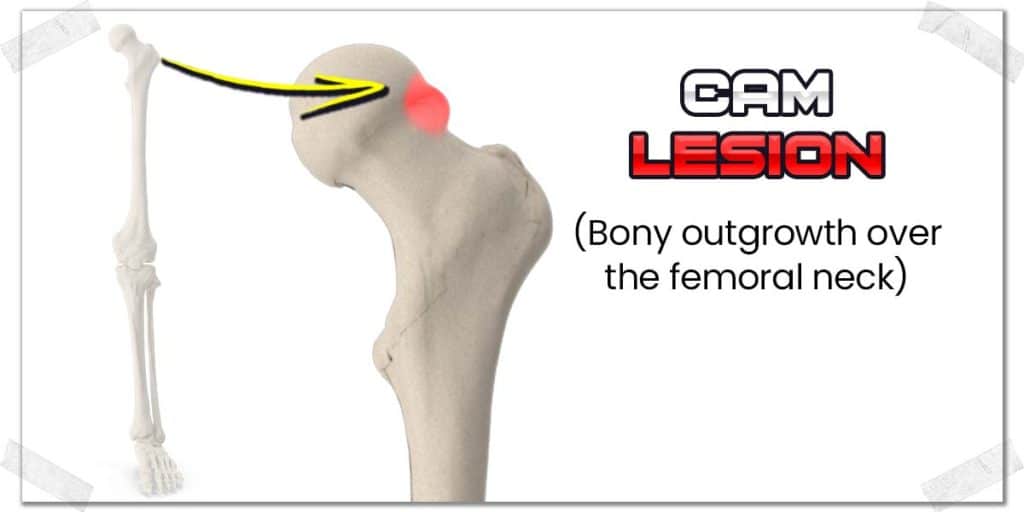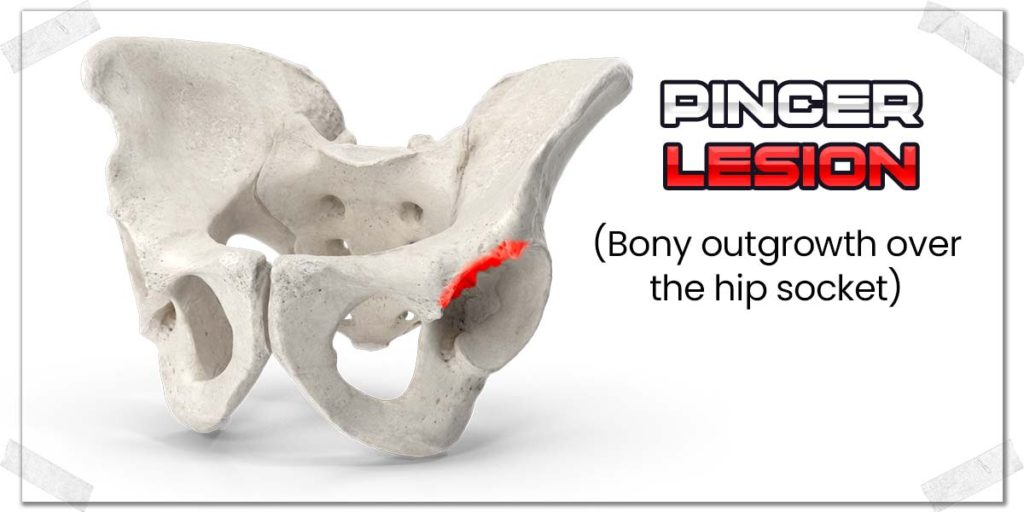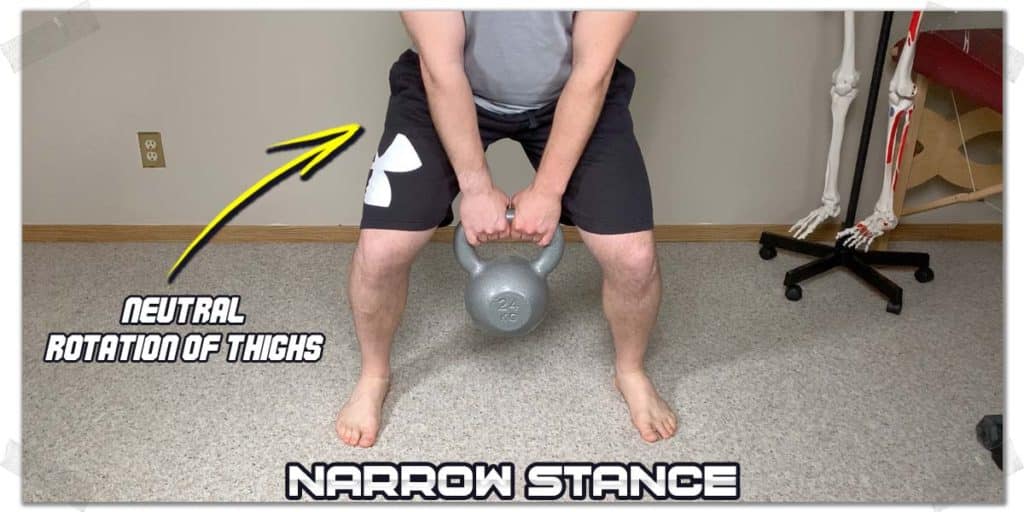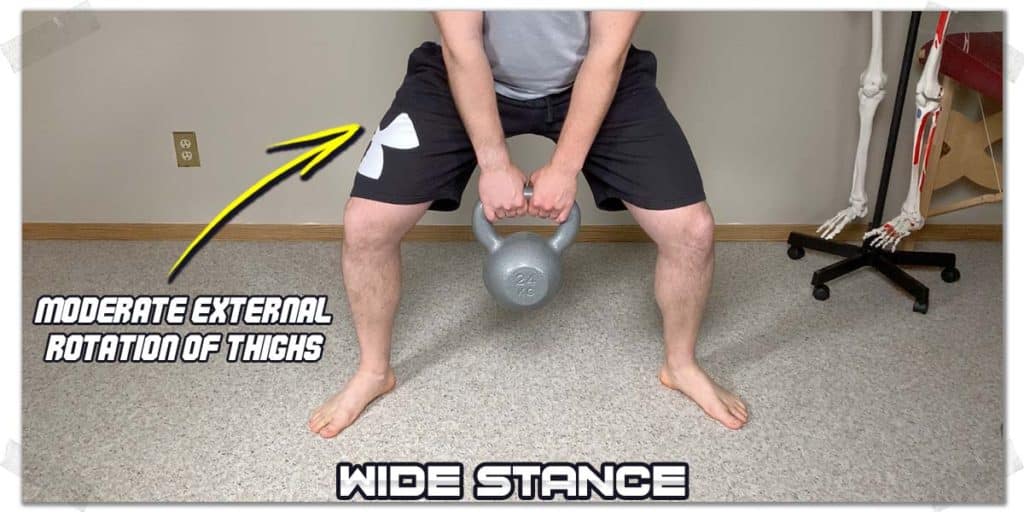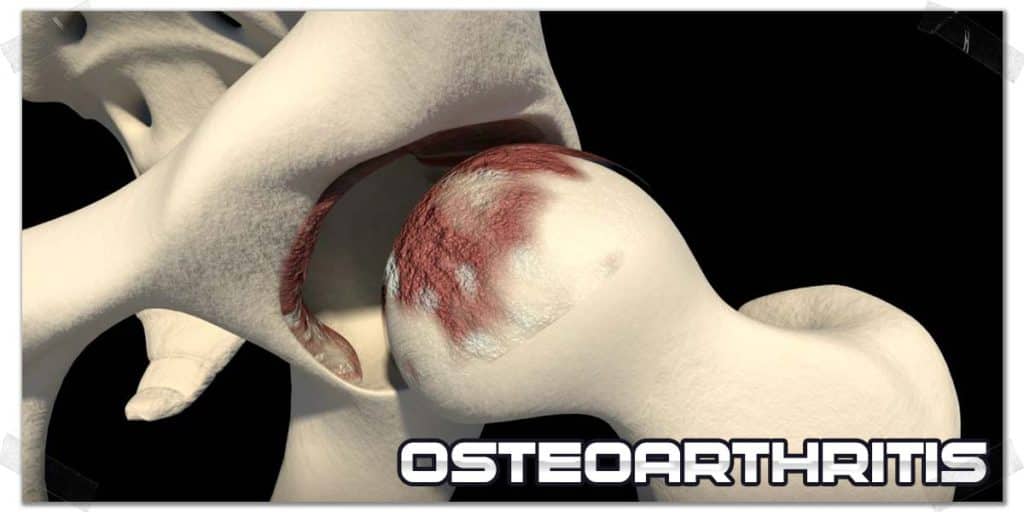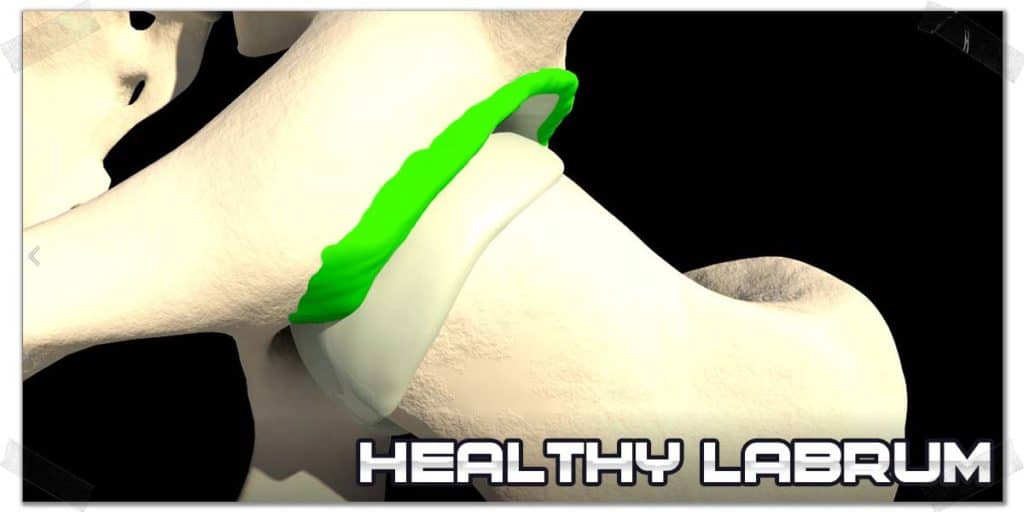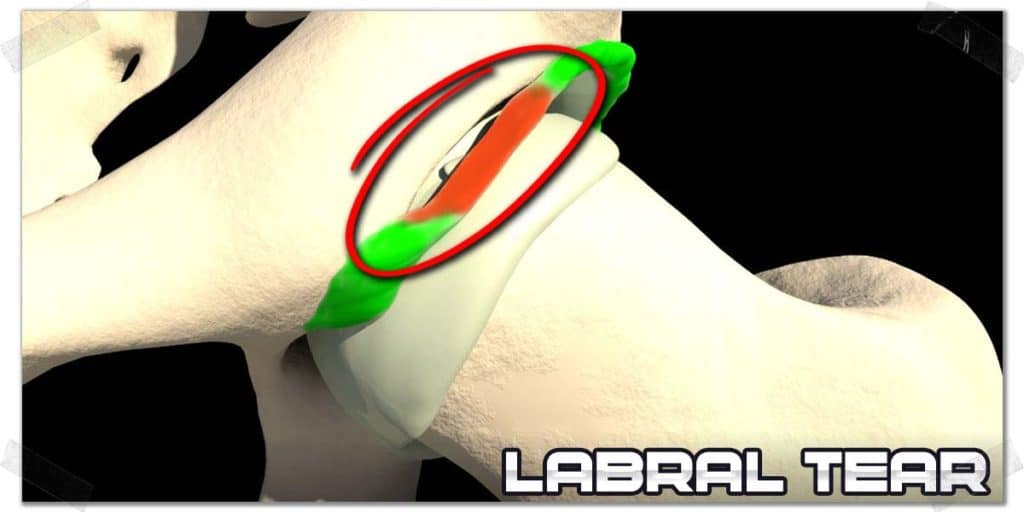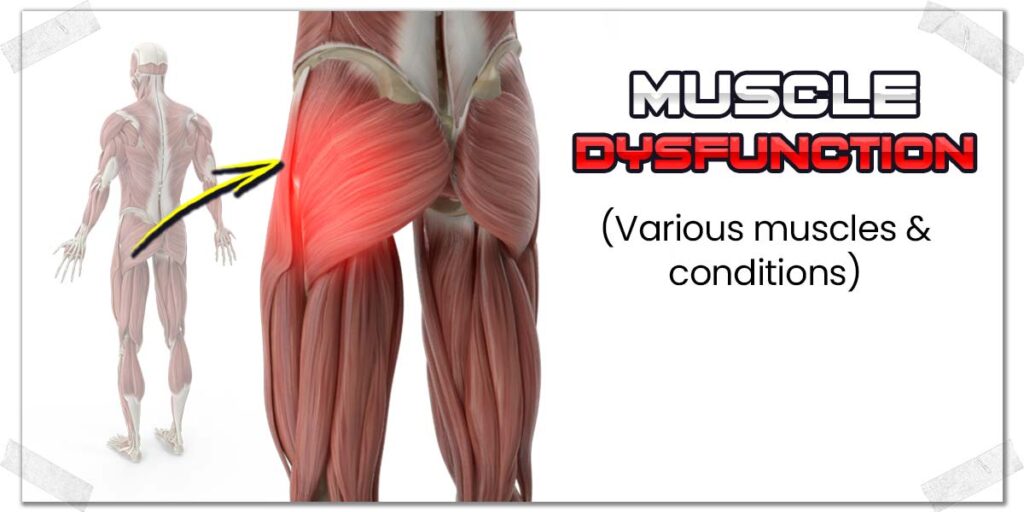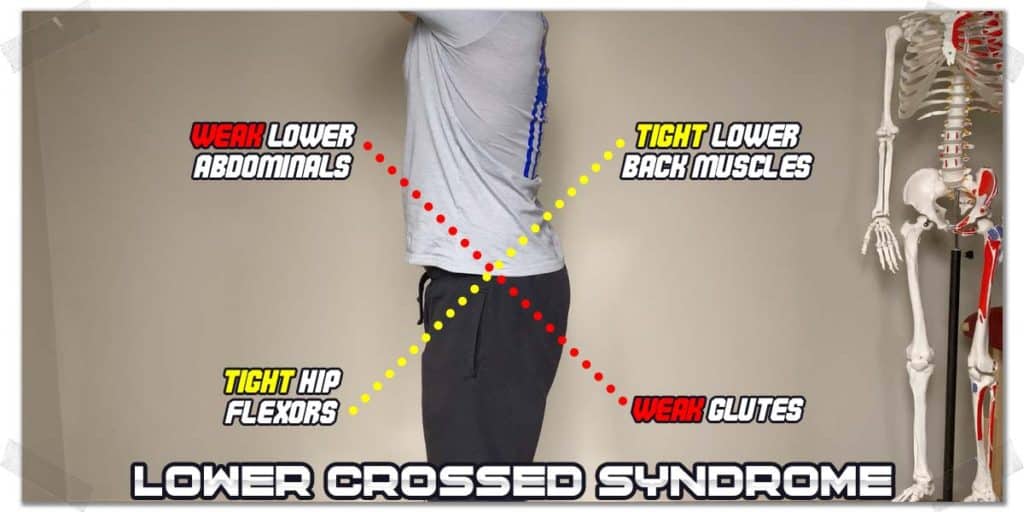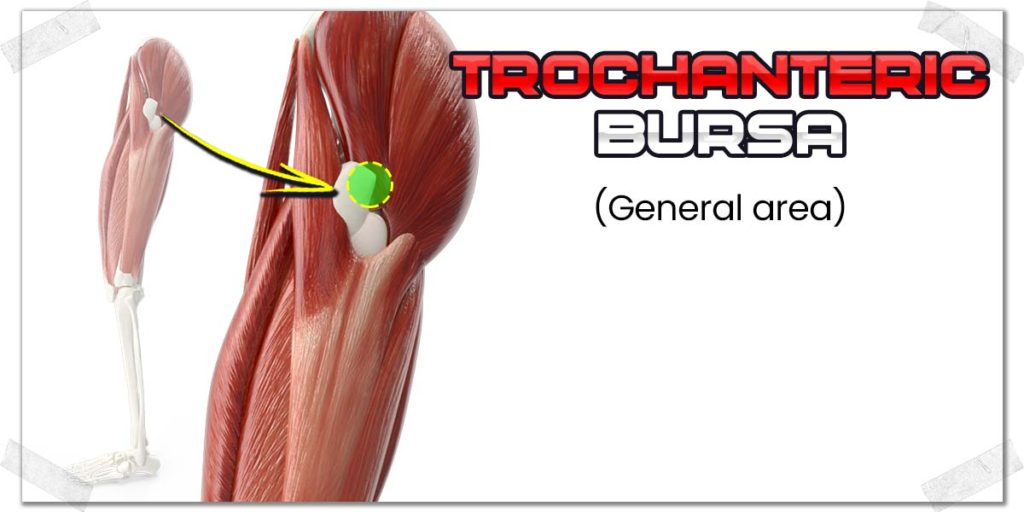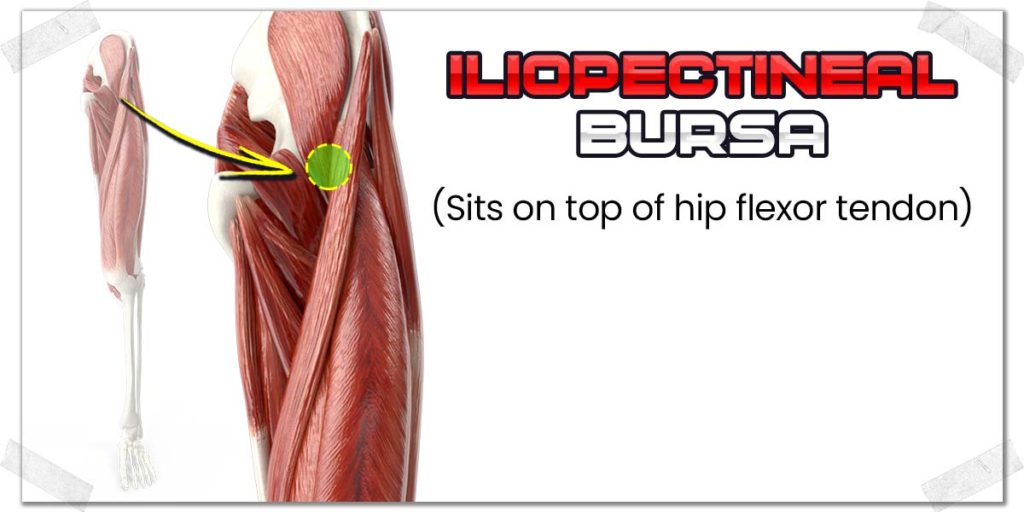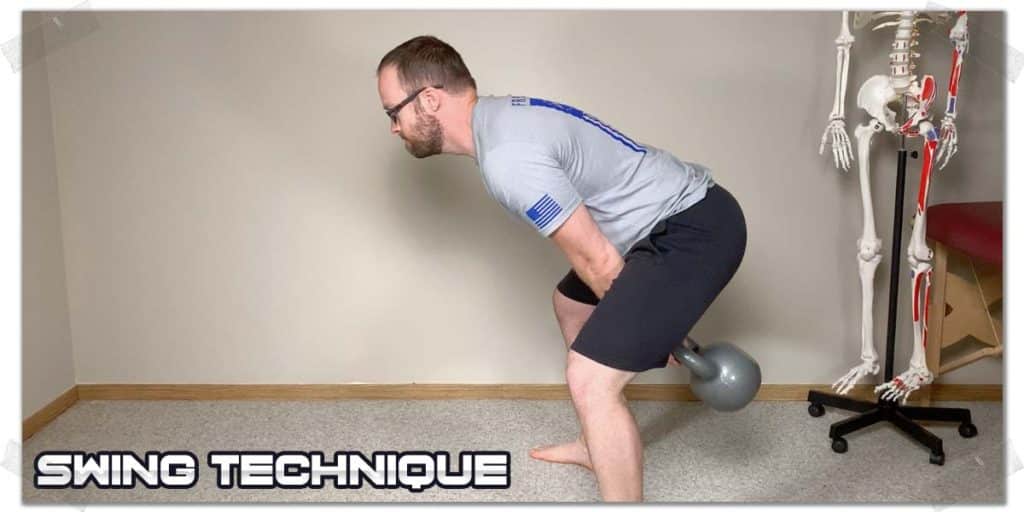If there were only three exercises that I could do for the rest of my life, the kettlebell swing would make the list. This exercise is far too valuable to leave out of your training. So, if it’s giving you hip pain, it’s absolutely worth doing all you possibly can to determine the cause of the issue. Doing so will give you a pathway forward for getting the issue under control, allowing you to keep on reaping the benefits of this invaluable exercise for all your days ahead.
Therefore, this article will provide a detailed starting point for understanding why this frustrating experience can occur and the best steps to take thereafter, depending on the underlying pain mechanism.
Hip pain from kettlebell swings can result from hip impingement, cartilage issues, muscle weakness or tightness, tendinopathy, bursitis, or poor technique. Solutions involve modifying your swing, improving muscle and tendon health, and optimizing your loading parameters during your workouts.
Take the time to read through this article if you’re serious about your hip health and your kettlebell swings; I will expand on these common issues in the informative sections below.
Related article: Hip Hinge Hamstring Pain: Causes & Solutions | Here’s What to do
Defining hip pain
“Hip pain” is a rather umbrella description for the dozens of orthopedic issues that can go wrong with the hip. While your pain might be deep with the hip joint itself, another reader’s “hip pain” may be out to the very side of their hip just underneath the skin, while another reader might feel their issue to be anywhere else around the front, sides or back of their upper thigh. No doubt that many readers of this article will be experiencing one type of “hip pain” that significantly differs from that of another reader.
As a result, I will cover everything I can with the most common conditions that affect the hip in these situations. It’s not an exhaustive list, but it absolutely contains the rather prevalent issues that can lead to pain in and around the hip when performing exercises such as the kettlebell swing.
There are numerous muscles, tissues, and structures that comprise the general hip region, and while I’d love to type out every single possible factor or condition that could cause your hip pain, it’s simply not practical. So, take the common issues discussed below and consider using them as a starting point for helping to point you in the right direction for your recovery.
Alright, let’s get to it!
Issue 1: Hip impingement
Femoroacetabular impingement (FAI), often simply referred to as hip impingement, is an orthopedic condition that causes sensations of pain and discomfort within the hip, most often with movements and exercises that involve hip flexion through squatting or hip flexion through hinging (both of which occur during the kettlebell swing).
The cause of discomfort results from a bony outgrowth on the head of the femur (known as a CAM lesion) or on the rim of the hip socket (known as a Pincer lesion). When the hip is flexed to a great enough extent, these bony outgrowths can contact the other bony part of the hip, causing pain and discomfort. This premature contact reduces the available range of motion within the hip for flexion-based movements.
Dealing with impingement
A true diagnosis of hip impingement will likely require an X-ray (to reveal any bony growths on the femur or acetabulum (the rim of the socket), along with symptoms that are consistent with FAI.1 It’s worth noting that 10 – 30% of the general population is believed to have either some type of CAM or Pincer (or mixed) pathology while being asymptomatic (not having any pain or other symptoms).2 So, an X-ray will only tell a portion of the story, so to speak.
There’s typically no universal consensus on the best single way to deal with FAI; however, there is good evidence to suggest that strengthening the muscles around the hip can be a very effective treatment option (for geeky reasons far beyond the scope of this article).3
So, if you know you have FAI, a good starting point would be to work with a professional who can help craft a specific hip strengthening regimen for your hip rotators and other key muscles around the hip.
Playing around with your swing stance
Since symptoms of FAI are often provoked with hip flexion movements such as squatting and hip hinging (resulting in premature contact of the bony structures of the acetabulum and femur), it is likely worthwhile to try modifying your stance when performing your swings.
Increasing your angle of toe-out (pointing your toes outwards) can change the position of the femur so that premature bony contact is no longer made when squatting or hip hinging. Additionally, widening (or sometimes even narrowing) your stance can also produce similar effects.
Most of the patient’s whom I treat with FAI report a reduction in symptoms when rotating their thighs outwards (pointing their toes outwards) than when compared to squatting with their toes pointing straight ahead for lower body exercises such as the kettlebell swing.
There’s no universal angle here for how much to rotate your toes (which rotates your thighs) outwards; you’ll need to play around with both of these factors and see if they yield a favorable reduction in hip pain or discomfort when performing your swings (and afterwards as well).
Issue 2: Cartilage issues
Cartilage is a type of connective tissue within the body that serves multiple roles. In the case of the hip, the two cartilage structures that are appropriate for mentioning in this article are the articular surfaces of the hip joint and the labrum. Each of these structures has unique roles in helping the hip to move and function properly.
Articular cartilage of the hip
Each portion of the ball and socket joint of the hip is covered with a very smooth layer of cartilage. The surface of the head of the femur interacts with the socket of the hip (the acetabulum). These two surfaces are able to roll and glide over one another when moving due to the smooth cartilage lining each surface.
Certain conditions can lead to a breakdown or roughening of these cartilage surfaces, which affects the joint’s ability to articulate smoothly, leading to pain and discomfort.
While multiple conditions can lead to this occurring, the most common is osteoarthritis (OA) of the hip.4
Hip osteoarthritis often presents with pain and stiffness within the hip and becomes more common in individuals with each passing decade of life. It’s estimated that up to 25% of the general population above the age of 55 are affected by this condition.5
If you’re in your first few decades of life and haven’t had any significant injuries or trauma to your hip, you’re likely not dealing with arthritic pain. However, you’re statistically more likely to be affected if you’re in your fifth or sixth decade.
Dealing with an arthritic hip
If it’s confirmed that your hip pain is coming from OA within the joint, take a deep breath — it’s not a death sentence. While you may need to modify your physical activities (including your kettlebell swings), you’ll need to stay physically active in order to keep your hip moving (while avoiding pain).
The extent to which you’ll need to modify your activities will depend on multiple factors, including how advanced your OA may or may not be. It will be best to get specific insight from a physical therapist or another qualified health specialist.
In the meantime, some considerations to make for your kettlebell swings can include:
- Being extra thorough with warmups before performing your swings (or other hip exercises, for that matter).
- Limiting the overall volume (sets, reps, weight) and frequency for which you perform your swings.
- Being mindful of the range of motion you’re putting through your hip(s) (you can try performing smaller swings and staying within a pain-free range).
- Avoid high-impact activities that can flare your hip joint up. These activities include lower body plyometrics (box jumps, broad jumps, etc.) and running.
The labrum
In addition to the articular cartilage, the labrum is the second piece of cartilage worth mentioning. The labrum is a fibrocartilage ring that wraps around the rim of the acetabulum (the hip socket). It improves the joint’s stability and acts as a shock absorber, joint lubricator and pressure distributor.6
Sometimes this little guy can get “scuffed up” or torn, typically with previous injuries and trauma to the hip involving twisting and shearing forces (car accident, sporting collision, a fall, etc.). When this happens, specific movements of the hip can become painful or problematic.
Nearly 75% of all labral tears can’t be attributed to a particular event or cause.6
Most labral tears that are painful present with pain in the front of the hip and in the groin. However, it can present elsewhere in the hip.6 Additionally, labral tears can produce clicking, or popping sensations, among others (though there is not always pain associated with these audible sounds).7
Dealing with labral tears
Depending on the location, extent, and pain of the labral tear, different treatment interventions can take place. However, conservative intervention is always the first approach (and the sole focus of this section).
If it’s confirmed you’re dealing with a labral tear, working with a qualified orthopedic specialist is an essential initial move to make. They will be able to fine-tune much more of your training than what I can do here in a blog article.
Nonetheless, here are some considerations when it comes to your kettlebell swings (and any other lower body exercise that gives you a similar pain):
- If you can play around with your hip and leg positioning so that you don’t experience any immediate or delayed pain when performing your swings, it’s likely fine (but no guarantee) to continue swinging away.
- If you can’t eliminate the pain, opting for other exercises, for the time being, is likely your best bet.
Other exercises you might want to consider can be:
- Glute bridges
- Cable or banded pull throughs
- Glute kickbacks
Issue 3: Muscle dysfunction
There are numerous issues and conditions that adversely affect the function of a muscle. When it comes to the muscles of the hip, common issues that can impact function and cause pain include:
- Muscle imbalances (some muscles being too weak while others are overpowered). This can be independent from or due to postural dysfunction (next point).
- Postural dysfunction, which can affect the mobility of the hips by some muscles being too tight and others being inhibited or “sleepy.” One common type of postural dysfunction commonly seen in the hips is lower crossed syndrome.
- Fascial restriction and trigger points within the muscle belly (this can result from postural dysfunction or for separate reasons)
Regardless of why the muscle(s) may be dysfunctional, restoring and optimizing their functional abilities is the ultimate goal when it comes to getting things back on track.
An entire book could be written on how to do this (many, in fact, have). Nonetheless, what follows are some of the starting points you’re going to need to consider:
Checking your ranges of motion
Since it’s a ball and socket joint, the hip can produce movement in any direction. As a result, there are a handful of muscles that work (contract) to produce these movements while the opposite hip muscles simultaneously must relax and stretch out to permit the movement to occur.
If you move your hip in any particular direction and feel sensations of tightness and stiffness when the tightness or stiffness shouldn’t be there, it could signify that your hip muscles are tight and perhaps can’t accommodate the position you’re attempting to move into.
Pro tip: If you’re not sure if your hip is suffering from limited range of motion or muscle tightness, compare its range of motion to your other hip, if possible. If you find differences in range of motion or tightness, it likely signifies that you’ve got a hip that isn’t moving as optimally as it should.
Treating trigger points and tightness
In the case of kettlebell swings, it’s often positions of the hips moving into extension (i.e. rising out of the squat) that produce sensations of tightness in the front of the hip.
Muscles of the hip that can often feel tight during the kettlebell swing include:
- The psoas
- The iliacus
- The rectus femoris
These muscles can often feel tight or uncomfortable during the swing as they must lengthen out in order to push the hips through into the extended position.
Since the kettlebell swing involves a wide stance, it’s also possible that your groin (inner thigh muscles) is lacking mobility. A wide stance while squatting can place a moderate-to-significant stretch on the upper portion of the groin — which is a position you’re exposed to with the kettlebell swing.
To get your groin muscles and rectus femoris (one of the quadriceps muscles) under control, performing soft-tissue treatments such as foam rolling and IASTM (preferably with a barbell sleeve) can be a great starting point if you’re attempting to treat the issue on your own.
While using a barbell can feel rather intense (it’s not for everyone), it’s also rather effective, at least from my anecdotal experiences with myself and numerous patients and clients whom I’ve treated and worked with.
If using a barbell isn’t your forte, using a traditional foam roller on a regular basis is likely your next best step.
Pro tip: The best time to foam roll is during your warmup for your workout, as foam rolling can help ensure your tissues are more prepared for the upcoming physical challenge of working out.
Get in the habit of doing this sort of soft tissue work on a daily basis. Make sure to hit your quads, IT band, hamstrings, adductors (groin muscles) and even your calves.
Daily postural positions
Lower crossed syndrome is quite prevalent in today’s society due to how much time we spend in a seated position each day.
The seated position places muscles on the front side of the hip in a shortened position while keeping muscles on the backside of the hip in a lengthened (stretched) position. The top of the kettlebell swing position places the exact opposite pattern of strengthening and lengthening on these respective hip muscles, which can feel uncomfortable or painful when performing swings.
Keeping the hips in a sustained sitting position for hours throughout multiple days of the week can lead to chronic shortening of muscles on the front side and inhibited muscle function on the backside. The end result is impaired movement around the hip, potentially with discomfort or pain — which you’ll likely feel when performing your kettlebell swings.
A great starting point for addressing postural dysfunction, such as lower crossed syndrome, is to think about exposing your hips to the exact opposite position they’re in when sitting. Doing this will help strengthen the muscles that are weak while lengthening the muscles that are chronically shortened or tight.
In the case of lower crossed syndrome:
- The lower abdominals and gluteal muscles tend to be weak
- The Hip flexors and the lower back muscles tend to be tight
Focusing on exercises and movements that help to lengthen and strengthen these respective muscle groups can lead to less pain, healthier hips and better functional performance with everything from kettlebell swings to lower body workouts to activities of daily living.
Optimizing your hip health by restoring and maintaining postural health is something just about anyone can benefit from — especially those who sit for large portions of the day, be it for work or other reasons.
Pro tip: One of the best exercises you can likely do to offset this dysfunctional pattern is the reverse Nordic curl.
Issue 4: Tendinopathy
Tendons are the gristle-like structures that interface between one end of a muscle and the bone to which it attaches. Every skeletal muscle has a tendon on each of its ends.
Tendons are prone to becoming unhealthy for various reasons, which results in a condition known as tendinopathy.
If a tendon is subjected to a highly repetitive task — specifically, one that exceeds the demand of which it is capable of sustaining — it can lead to an acute (brand new) inflammation of the tendon, which can lead to tendonitis.
Pro tip: when a tendon is repetitively overworked to the point of becoming painful, it is classified as a repetitive strain injury.
Tendonitis isn’t as common as we once thought it was (the suffix “itis” refers to an active inflammation process within a tissue). Rather, unhealthy tendons are more often in a state of tendinosis, where the tendon remains unhealthy and without any signs of active inflammation in the area.8
Tendon issues are extremely common within individuals, and tendons within the hip are some of the most commonly affected.
The most commonly affected hip tendons are:
- The glute medius
- The glute minimus
- The upper (proximal) hamstrings
Dealing with hip tendinosis
While it’s incredibly annoying to have and stubborn to deal with, the good news is that around 80% of mild to moderate cases of tendinosis can usually be cleaned up with conservative treatment.9 A combination of therapeutic strengthening, some physical therapy, and persistence are usually all that it takes when the tendinosis is not severe.
Related article: The BEST Glute Medius & Minimus Exercise That No One Is Showing You
You’re going to need to start by getting a diagnosis of which tendons(s) are affected. As a guidepost, consider the following:
- Tendon-based pain is typically dull, achy, somewhat diffuse, and rather intermittent. It’s most often felt during an activity or afterwards. It also tends to not hurt much (or at all) when at rest.
- Tendon pain around the outside of your hip, typically just above the greater trochanter, is often the result of the glute medius or minimus tendon.
- Tendon pain just underneath or right along the bottom of your butt cheek (the gluteal fold) is often the result of proximal hamstring tendinosis.
- Tendon pain high up in your groin could be the result of adductor tendinosis.
Once you know which muscle(s) is/are the culprit, a general tendon loading (resistance training)protocol specific to the affected muscle(s) is your best bet, combined with additional physical therapy interventions. These other interventions can include:
- Extracorporeal shockwave therapy
- Laser therapy
- Cross friction massage
- Intramuscular stimulation
Be persistent and patient with your tendon loading exercises; they take time, but if you’re dialling everything in correctly, you should begin to feel improvement within a few weeks.
Issue 5: Bursitis
The human body is filled with over 200 water balloon-like discs called bursas, which act as cushions to reduce the amount of friction that can occur when your tendons glide and slide over the otherwise bumpy and rough surfaces of the bone they’re resting on.
These bursa pads — just like nearly any other tissue in the body — can become irritated, inflamed and sore. When this occurs, the condition is known as bursitis.
There are two particular bursas of the hip that are commonly inflamed, both of which can be quite painful. These are the trochanteric bursa and the iliopectineal bursa, with the former being more common than the latter. Let’s look at each in a bit more detail.
Trochanteric bursitis
The trochanteric bursa sits directly on top of the greater trochanter, which is the bumpy sort of knob you feel on the outside of your upper thigh. When it becomes inflamed, it can produce sensations of pain or discomfort anywhere along the outer aspects of the hip. It tends to occur due to excessive amounts of friction or pressure, high volumes of physical activity, and even from direct trauma. While it tends to affect women more than men, it’s rather common in both sexes.
Iliopectineal bursitis
The iliopectineal bursa (often called the iliopsoas bursa) sits directly in front of the hip capsule (the hip capsule covers the ball and socket joint of the hip) and is directly underneath the iliopsoas tendon (the hip flexor tendon). While this bursa can become inflamed and enlarged for various reasons, it is often seen in highly active individuals involved in strength training, running, and other sporting activities.
Dealing with bursitis of the hip
Regardless of which bursa has become inflamed, there are some general steps you’ll want to consider and implement to help get the pain and discomfort under control. Since it can be a bit tricky to diagnose bursitis, you will want to make sure you have the utmost confidence (i.e., a professional evaluation) in knowing that your bursa is the pain source (or, at least, contributing to your pain).
Pro tip: Bursitis can take time to resolve, so be patient. Thankfully there are several conservative interventions that can help.
The general starting points I often consider for those dealing with bursitis of the hip are:
- Modifying lower body exercises for the time being. Whether it’s simply a matter of changing your stance slightly during the kettlebell swing or foregoing them for the time being, you only want to be performing lower body exercises that aren’t flaring your pain in the process.
- Improving the mobility of your IT band and thigh in general. Since bursitis (particularly trochanteric bursitis) can result from excessive compression of the bursa, mobilizing the tissues on top of the bursa can prove to be helpful.10 Simple self-treatments to do so include foam rolling and gentle dynamic stretches. Just make sure you do not do any foam rolling directly over the bursa; treat around the area of the bursa.
- Strengthening of the hip rotator muscles. These muscles are often weak or underperforming in those with hip bursitis (particularly with iliopectineal bursitis).11 Strengthening these muscles can help lead to better control, movement, and function of the hip, which can reduce irritation of the bursa. A daily strengthening regimen for these muscles can be a good starting point; however, your frequency may vary based on your overall condition.
Issue 6: Poor swing technique
Sometimes the underlying cause of a condition or dysfunction occurring within the hip is by no fault of your own. Other times, pain can be from a simple issue involving your exercise technique, in this particular case, your swing technique.
If your pain only comes on during your swings and with no other exercises or with any other daily activities, you’ll definitely want to make sure your swing technique is on point. If left uncorrected, it could certainly lead to other orthopedic issues or chronic pain.
Related article: Why Your Wrists Hurt After Kettlebell Swings (Solutions & Easy Fixes)
While there’s room for individual tweaking and variation for each individual based on different factors, here are the key factors to keep in mind:
- Keep your toes pointed slightly outward when in your swing stance; this will externally rotate your thigh bones (femurs) which will help to create a more ideal positioning of the ball and socket joint (known as an open packed position). The result will be a more ideal articulation of the joint during the swing (even if you don’t have FAI).
- Use a stance that’s slightly wider than shoulder width. This will help set the hip joint in more of an open-packed position. You can go wider if desired, just keep it within reason and make sure it feels good.
- Squeeze your butt when you swing upwards (it will help activate your glutes further and thus, help you to generate more power during the swing). Just make sure that you’re not squeezing so hard that it’s causing you to cramp up or experience other forms of hip discomfort.
Final thoughts
Because the kettlebell swing offers so many profound benefits, it’s one you want to keep doing for all your days ahead; there are just too many substantial benefits you’ll miss out on if you can’t do swings due to pain.
Take the tips and insight within this article and use them to help get you pointed in the general direction of getting to the root cause of your pain. Get a qualified professional in your corner, if at all possible. Be diligent and patient; working through pain and injuries isn’t fun, but it’s something that all of us have to do at one point or another.
Be smart and keep working hard. You’ve got this.
References:
4. Lespasio MJ, Sultan AA, Piuzzi NS, et al. Hip osteoarthritis: a primer. Perm J. 2018;22.

Hi! I’m Jim Wittstrom, PT, DPT, CSCS, Pn1.
I am a physical therapist who is passionate about all things pertaining to strength & conditioning, human movement, injury prevention and rehabilitation. I created StrengthResurgence.com in order to help others become stronger and healthier. I also love helping aspiring students and therapists fulfill their dreams of becoming successful in school and within their clinical PT practice. Thanks for checking out my site!

